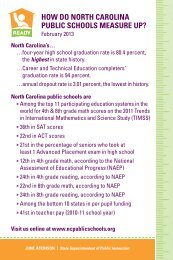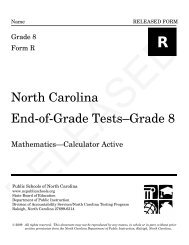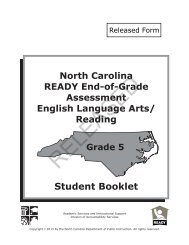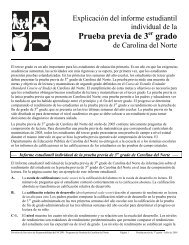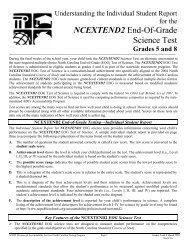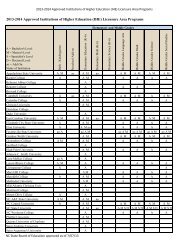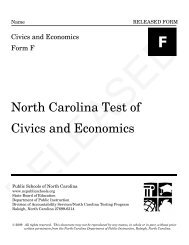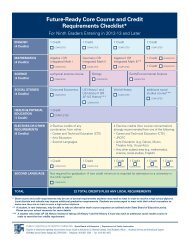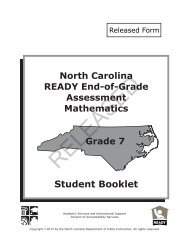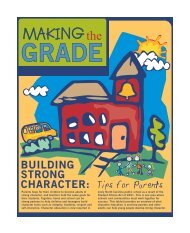ELA/Reading Grade 8 - Public Schools of North Carolina
ELA/Reading Grade 8 - Public Schools of North Carolina
ELA/Reading Grade 8 - Public Schools of North Carolina
Create successful ePaper yourself
Turn your PDF publications into a flip-book with our unique Google optimized e-Paper software.
Released Form<br />
<strong>North</strong> <strong>Carolina</strong><br />
READY End-<strong>of</strong>-<strong>Grade</strong><br />
Assessment<br />
English Language Arts/<br />
<strong>Reading</strong><br />
<strong>Grade</strong> 8<br />
RELEASED<br />
Student Booklet<br />
Academic Services and Instructional Support<br />
Division <strong>of</strong> Accountability Services<br />
Copyright 2013 by the <strong>North</strong> <strong>Carolina</strong> Department <strong>of</strong> <strong>Public</strong> Instruction. All rights reserved.
GRADE 8 E NGLISH L ANGUAGE A RTS/READING— R ELEASED F ORM<br />
Song (1914)<br />
by Rupert Brooke<br />
All suddenly the wind comes s<strong>of</strong>t,<br />
And Spring is here again;<br />
And the hawthorn quickens with buds <strong>of</strong> green,<br />
And my heart with buds <strong>of</strong> pain.<br />
5 My heart all Winter lay so numb<br />
The earth is dead and frore, *<br />
That I never thought the Spring would come,<br />
Or my heart wake any more.<br />
But Winter’s broken and earth has woken,<br />
10 And the small birds cry again;<br />
And the hawthorn hedge puts forth its buds,<br />
And my heart puts forth its pain.<br />
* frore: frozen<br />
RELEASED<br />
1 Go to the next page.
GRADE 8 E NGLISH L ANGUAGE A RTS/READING— R ELEASED F ORM<br />
S1 What can be inferred from line 5<br />
A<br />
B<br />
C<br />
D<br />
The speaker’s heart is asleep.<br />
The speaker’s heart is afraid.<br />
The speaker’s heart is paralyzed.<br />
The speaker’s heart is extremely cold.<br />
S2<br />
In the second stanza, how does the poet’s choice <strong>of</strong> words impact the meaning <strong>of</strong><br />
the poem<br />
A<br />
B<br />
C<br />
D<br />
It gives the differences between Winter and Spring.<br />
It describes how cold it gets during Winter.<br />
It explains how the speaker views the different seasons.<br />
It emphasizes the despair the speaker feels about the loss <strong>of</strong> Spring.<br />
RELEASED<br />
2
GRADE 8 E NGLISH L ANGUAGE A RTS/READING— R ELEASED F ORM<br />
Excerpt from “In the Old Valley”<br />
by Lucy Maud Montgomery<br />
The man halted on the crest <strong>of</strong> the hill and looked somberly down into the long valley<br />
below. It was evening, and although the hills around him were still in the light, the<br />
valley was already filled with kindly, placid shadows. A wind that blew across it from the<br />
misty blue sea beyond was making wild music in the rugged firs above his head as he<br />
stood in an angle <strong>of</strong> the weather-grey longer fence, knee-deep in bracken. It had been<br />
by these firs he had halted twenty years ago, turning for one last glance at the valley<br />
below, the home valley which he had never seen since. But then the firs had been little<br />
more than vigorous young saplings; they were tall, gnarled trees now, with lichened<br />
trunks, and their lower boughs were dead. But high up, their tops were green and<br />
caught the saffron light <strong>of</strong> the west. He remembered that when a boy, he had thought<br />
there was nothing more beautiful than the evening sunshine falling athwart the dark<br />
green fir boughs on the hills.<br />
As he listened to the swish and murmur <strong>of</strong> the wind, the earth-old tune with the power<br />
to carry the soul back to the dawn <strong>of</strong> time, the years fell away from him, and he forgot<br />
much, remembering more. He knew now that there had always been a longing in his<br />
heart to hear the wind-chant in the firs. He had called that longing by other names, but<br />
he knew it now for what it was when, hearing, he was satisfied.<br />
He was a tall man with iron-grey hair and the face <strong>of</strong> a conqueror—strong, pitiless,<br />
unswerving. Eagle eyes, quick to discern and unfaltering to pursue; jaw square and<br />
intrepid; mouth formed to keep secrets and cajole men to his will—a face that hid much<br />
and revealed little. It told <strong>of</strong> power and intellect, but the soul <strong>of</strong> the man was a hidden<br />
thing. . . . Yonder below him was home—the old house that had sheltered him, the<br />
graves <strong>of</strong> his kin, the wide fields where his boyhood dreams had been dreamed.<br />
RELEASED<br />
Should he go down to it This was the question he asked himself. He had come back to<br />
it, heartsick <strong>of</strong> his idols <strong>of</strong> the marketplace. For years they had satisfied him, the buying<br />
and selling and getting gain, the pitting <strong>of</strong> strength and craft against strength and craft,<br />
the tireless struggle, the exultation <strong>of</strong> victory. Then, suddenly, they had failed their<br />
worshipper; they ceased to satisfy; the sacrifices he had heaped on their altars availed<br />
him nothing in this new need and hunger <strong>of</strong> his being. . . . Were there not better things<br />
than these, things he had once known and loved and forgotten Where were the ideals<br />
<strong>of</strong> his youth, the l<strong>of</strong>ty aspirations that had upborne him then Where was the eagerness<br />
and zest <strong>of</strong> new dawns, the earnestness <strong>of</strong> well-filled, purposeful hours <strong>of</strong> labor, the<br />
satisfaction <strong>of</strong> a good day worthily lived, at eventide the unbroken rest <strong>of</strong> long, starry<br />
nights Where might he find them again Were they yet to be had for the seeking in the<br />
3<br />
Go to the next page.
GRADE 8 E NGLISH L ANGUAGE A RTS/READING— R ELEASED F ORM<br />
old valley With the thought came a great yearning for home. He had had many<br />
habitations, but he realized now that he had never thought <strong>of</strong> any <strong>of</strong> these places as<br />
home. That name had all unconsciously been kept sacred to the long, green, seawardlooking<br />
glen where he had been born.<br />
So he had come back to it, drawn by a longing not to be resisted. But at the last he felt<br />
afraid. There had been many changes, <strong>of</strong> that he felt sure. Would it still be home And if<br />
not, would not the loss be most irreparable and bitter Would it not be better to go<br />
away, having looked at it from the hill and having heard the saga <strong>of</strong> the firs, keeping his<br />
memory <strong>of</strong> it unblurred, than risk the probable disillusion <strong>of</strong> a return to the places that<br />
had forgotten him and friends whom the varying years must certainly have changed as<br />
he had changed himself No, he would not go down. It had been a foolish whim to come<br />
at all—foolish, because the object <strong>of</strong> his quest was not to be found there or elsewhere.<br />
He could not enter again into the heritage <strong>of</strong> boyhood and the heart <strong>of</strong> youth. He could<br />
not find there the old dreams and hopes that had made life sweet. He understood that<br />
he could not bring back to the old valley what he had taken from it. He had lost that<br />
intangible, all-real wealth <strong>of</strong> faith and idealism and zest; he had bartered it away for the<br />
hard, yellow gold <strong>of</strong> the marketplace, and he realized at last how much poorer he was<br />
than when he had left that home valley. His was a name that stood for millions, but he<br />
was beggared <strong>of</strong> hope and purpose.<br />
1 Which detail from the selection supports the development <strong>of</strong> the central idea<br />
A<br />
B<br />
C<br />
D<br />
“It had been by these firs he had halted twenty years ago, turning for one<br />
last glance at the valley below, the home valley which he had never seen<br />
since.”<br />
“He remembered that when a boy, he had thought there was nothing more<br />
beautiful than the evening sunshine falling athwart the dark green fir boughs<br />
on the hills.”<br />
“Yonder below him was home—the old house that had sheltered him, the<br />
graves <strong>of</strong> his kin, the wide fields where his boyhood dreams had been<br />
dreamed.”<br />
“He understood that he could not bring back to the old valley what he had<br />
taken from it.”RELEASED<br />
4<br />
Go to the next page.
GRADE 8 E NGLISH L ANGUAGE A RTS/READING— R ELEASED F ORM<br />
2 Which statement summarizes the selection<br />
A<br />
B<br />
C<br />
The trees that were once only saplings are now full-grown and withered.<br />
The speaker misses his previous home, but realizes it would not be the same<br />
if he returned there after many years.<br />
The speaker remembers more <strong>of</strong> his previous home than he has forgotten.<br />
D<br />
The thrill <strong>of</strong> the marketplace no longer satisfies the speaker.<br />
3 According to the selection, what did the man seek from the valley<br />
A<br />
B<br />
C<br />
D<br />
the feeling <strong>of</strong> hope and purpose<br />
the ability to observe nature<br />
the chance to see his family and friends<br />
the desire to borrow money<br />
4 Based on the sentences below, what does saffron mean<br />
“But high up, their tops were green and caught the saffron light <strong>of</strong> the west. He<br />
remembered that when a boy, he had thought there was nothing more beautiful<br />
than the evening sunshine falling athwart the dark green fir boughs on the hills.”<br />
A<br />
B<br />
green<br />
yellow<br />
RELEASED<br />
C<br />
D<br />
dark<br />
west<br />
5<br />
Go to the next page.
GRADE 8 E NGLISH L ANGUAGE A RTS/READING— R ELEASED F ORM<br />
5 In the sentence below, what is conveyed by comparing the sound <strong>of</strong> the wind to a<br />
murmur<br />
“As he listened to the swish and murmur <strong>of</strong> the wind, the earth-old tune with the<br />
power to carry the soul back to the dawn <strong>of</strong> time, the years fell away from him,<br />
and he forgot much, remembering more.”<br />
A<br />
The wind is rolling.<br />
B<br />
C<br />
D<br />
The wind is frightening.<br />
The wind is gentle.<br />
The wind is powerful.<br />
6 In the sentence below, why did the man feel foolish<br />
“It had been a foolish whim to come at all—foolish, because the object <strong>of</strong> his quest<br />
was not to be found there or elsewhere.”<br />
A<br />
B<br />
C<br />
D<br />
He realizes that he cannot solve his problems by coming home.<br />
He finally understands that coming home was a mistake.<br />
He discovers that his home is not as wonderful as he had thought.<br />
He believes that his life is better now than when he was young.<br />
RELEASED<br />
7 What do the sentences below reveal about the character<br />
“He had lost that intangible, all-real wealth <strong>of</strong> faith and idealism and zest; he had<br />
bartered it away for the hard, yellow gold <strong>of</strong> the marketplace, and he realized at<br />
last how much poorer he was than when he had left that home valley. His was a<br />
name that stood for millions, but he was beggared <strong>of</strong> hope and purpose.”<br />
A<br />
B<br />
C<br />
D<br />
He would trade his fortune for happiness.<br />
He was very poor.<br />
He wanted to be a boy again.<br />
He did not miss his home greatly.<br />
6<br />
Go to the next page.
GRADE 8 E NGLISH L ANGUAGE A RTS/READING— R ELEASED F ORM<br />
Park Geology<br />
Padre Island National Seashore, Texas<br />
Pr<strong>of</strong>ile <strong>of</strong> a Barrier Island<br />
Padre Island is one <strong>of</strong> a chain <strong>of</strong> islands that stretches along the Atlantic and Gulf coasts<br />
<strong>of</strong> the United States from Maine to Texas. These islands are barrier islands, so-called<br />
because they guard the mainland from the direct onslaught <strong>of</strong> storms. On many <strong>of</strong> these<br />
low-lying islands, man has left his mark: seaside homes, lighthouses, fishing villages,<br />
vacation resorts. But on Padre Island, it is not the work <strong>of</strong> man but the handiwork <strong>of</strong><br />
nature that is most evident.<br />
Padre Island, like all barrier islands, is a dynamic place where you can witness change:<br />
<br />
<br />
<br />
change wrought by the gentle touch <strong>of</strong> breezes,<br />
by the relentless crashing <strong>of</strong> waves,<br />
by the rhythmic coming and going <strong>of</strong> tides, and, most dramatically, by the<br />
violent battering <strong>of</strong> tropical storms and hurricanes.<br />
The many environments <strong>of</strong> Padre Island—beach, dunes, grasslands, and tidal flats—are<br />
shaped and reshaped daily in response to these natural sculptors. You can see the signs<br />
<strong>of</strong> change everywhere: sand blowing in the wind, new seashells deposited by a wave, a<br />
washover channel cut into the island by the power <strong>of</strong> a great storm. Another more subtle<br />
change that is occurring, according to scientists, is the slow expansion <strong>of</strong> the entire<br />
island toward the mainland as winds and storms deposit sand on the island’s west side.<br />
RELEASED<br />
The plants and animals <strong>of</strong> Padre Island are well-adapted to the ever-changing nature <strong>of</strong><br />
their native home. Sea oats, for example, thrive here. This wild shore plant is a pioneer<br />
species, one that moves into areas <strong>of</strong> loose, blowing sand where few other plants can<br />
grow and takes root. With the sand anchored by roots, other plants take hold and dunes<br />
grow, sometimes to heights <strong>of</strong> 30 or 40 feet. The dunes are held in place unless<br />
something destroys the plants. A particularly fierce storm can do it. People can do it, by<br />
trampling the grasses or driving over them; that’s why hiking and driving in the dunes<br />
are prohibited.<br />
For years, legends have been told <strong>of</strong> great treasures hidden on Padre Island and just <strong>of</strong>f<br />
its shores. The stories are <strong>of</strong> fortunes <strong>of</strong> gold and silver carried by Spanish galleons lost<br />
at sea and <strong>of</strong> vast sums <strong>of</strong> money and gems buried in the sand. Some <strong>of</strong> this wealth has<br />
7<br />
Go to the next page.
GRADE 8 E NGLISH L ANGUAGE A RTS/READING— R ELEASED F ORM<br />
indeed been found, and more may be discovered in the future. Meanwhile, there are<br />
natural treasures just as great—perhaps even greater—to enjoy in Padre Island National<br />
Seashore. Located along the south Texas coast, this sparkling preserve by the sea<br />
embraces 80 miles <strong>of</strong> white sand-and-shell beaches, picturesque windswept dunes, wild<br />
landscapes <strong>of</strong> grasslands and tidal flats teeming with shore life, and warm <strong>of</strong>fshore<br />
waters. The National Seashore is one <strong>of</strong> the longest stretches <strong>of</strong> primitive, undeveloped<br />
ocean beach in the United States. Throughout this coastal wilderness, you can enjoy the<br />
riches <strong>of</strong> relaxation and recreation.<br />
<br />
<br />
If you’re a beach-lover, the sun, sand, and surf <strong>of</strong> Padre Island are ideal for<br />
swimming and sunbathing almost all year.<br />
If you’re a fisherman, you can choose between the Gulf <strong>of</strong> Mexico and the<br />
shallow, extremely salty waters <strong>of</strong> Laguna Madre—both are renowned for<br />
their bounty <strong>of</strong> game fish.<br />
For those who delight in the discovery <strong>of</strong> a seashell <strong>of</strong> exquisite design and color, or a<br />
peculiar piece <strong>of</strong> driftwood, there are miles <strong>of</strong> shoreline for beachcombing. Campers can<br />
awake to the sights and sounds <strong>of</strong> water and island birds such as gulls, herons, and<br />
ducks that live by the water’s edge. If it’s adventure and a chance to get away from it all<br />
that you seek, you can hike or drive a 4-wheel-drive vehicle along the long roadless Gulf<br />
beach. For those who like to poke around in the past, Padre Island has a history <strong>of</strong> small<br />
Indian tribes that once hunted and fished here, shipwrecks, hurricanes, cattle ranches,<br />
and oil and gas exploration. However you spend your time at Padre Island National<br />
Seashore, the rewards will be generous.<br />
RELEASED<br />
8 Based on the sentence below, how does the personification <strong>of</strong> nature emphasize<br />
the author’s point<br />
“But on Padre Island, it is not the work <strong>of</strong> man but the handiwork <strong>of</strong> nature that is<br />
most evident.”<br />
A<br />
B<br />
C<br />
D<br />
It shows that nature is the main force <strong>of</strong> change on the island.<br />
It shows that man has built many structures along the island.<br />
It shows the importance <strong>of</strong> lighthouses on rocky beaches.<br />
It shows the response <strong>of</strong> wildlife to the island.<br />
8<br />
Go to the next page.
GRADE 8 E NGLISH L ANGUAGE A RTS/READING— R ELEASED F ORM<br />
9 Which event creates dramatic changes on Padre Island<br />
A<br />
B<br />
C<br />
D<br />
“the gentle touch <strong>of</strong> breezes”<br />
“the relentless crashing <strong>of</strong> waves”<br />
“the rhythmic coming and going <strong>of</strong> tides”<br />
“the violent battering <strong>of</strong> tropical storms and hurricanes”<br />
RELEASED<br />
10 Which statement explains the sentence below<br />
“The many environments <strong>of</strong> Padre Island—beach, dunes, grasslands, and tidal<br />
flats—are shaped and reshaped daily in response to these natural sculptors.”<br />
A Natural elements constantly change the surface <strong>of</strong> Padre Island.<br />
B The plants and animals <strong>of</strong> Padre Island have adapted to the natural changes<br />
to its environment.<br />
C A large storm changed the environments <strong>of</strong> Padre Island.<br />
D Padre Island is expanding toward the Texas mainland.<br />
11 Which phrase from the sentence below, helps the reader determine the meaning <strong>of</strong><br />
the word subtle<br />
“Another more subtle change that is occurring, according to scientists, is the slow<br />
expansion <strong>of</strong> the entire island toward the mainland as winds and storms deposit<br />
sand on the island’s west side.”<br />
A “entire island”<br />
B “winds and storms”<br />
C “slow expansion”<br />
D “deposit sand”<br />
9<br />
Go to the next page.
GRADE 8 E NGLISH L ANGUAGE A RTS/READING— R ELEASED F ORM<br />
12 Why are sea oats considered to be a pioneer species<br />
A<br />
B<br />
C<br />
D<br />
They are native to the area.<br />
They adapt well and take root in sand.<br />
They are difficult to destroy.<br />
They can grow to heights <strong>of</strong> 30 or 40 feet.<br />
13 Why does the author compare the natural beauty <strong>of</strong> Padre Island to the island’s<br />
legendary hidden treasures<br />
A<br />
B<br />
C<br />
D<br />
The author believes the legends <strong>of</strong> hidden treasures are unrealistic.<br />
The author believes that hidden treasures are difficult to find because <strong>of</strong> the<br />
many huge sand dunes.<br />
The author believes future generations will continue to find treasures at<br />
Padre Island.<br />
The author believes the relaxation and recreation available at Padre Island<br />
are as valuable as treasures.<br />
14 How are the bullet points used to further the author’s purpose<br />
A<br />
B<br />
C<br />
The bullet points break up the pattern <strong>of</strong> the selection.<br />
RELEASED<br />
The bullet points highlight old legends.<br />
The bullet points place emphasis on important facts.<br />
D<br />
The bullet points interrupt the flow <strong>of</strong> the information.<br />
10<br />
Go to the next page.
GRADE 8 E NGLISH L ANGUAGE A RTS/READING— R ELEASED F ORM<br />
15 What was the author’s purpose in writing this selection<br />
A<br />
B<br />
C<br />
to explain why sand dunes are important and must be preserved<br />
to educate people and encourage tourism on Padre Island<br />
to show that the hidden treasure <strong>of</strong> Padre Island is more valuable than its<br />
natural beauty<br />
D<br />
to demonstrate a need for national protection <strong>of</strong> all barrier islands<br />
16 Which claim made by the author has insufficient evidence to support its accuracy<br />
A<br />
B<br />
C<br />
D<br />
“But on Padre Island, it is not the work <strong>of</strong> man but the handiwork <strong>of</strong> nature<br />
that is most evident.”<br />
“The many environments <strong>of</strong> Padre Island—beach, dunes, grasslands, and<br />
tidal flats—are shaped and reshaped daily in response to these natural<br />
sculptors.”<br />
“The plants and animals <strong>of</strong> Padre Island are well-adapted to the<br />
ever-changing nature <strong>of</strong> their native home.”<br />
“However you spend your time at Padre Island National Seashore, the<br />
rewards will be generous.”<br />
RELEASED<br />
11<br />
Go to the next page.
GRADE 8 E NGLISH L ANGUAGE A RTS/READING— R ELEASED F ORM<br />
A Pinch <strong>of</strong> Salt<br />
by Robert Graves<br />
When a dream is born in you<br />
With a sudden clamorous pain<br />
When you know the dream is true<br />
And lovely, with no flaw nor stain,<br />
5 O then, be careful, or with sudden clutch<br />
You’ll hurt the delicate thing you prize so much.<br />
Dreams are like a bird that mocks,<br />
Flirting the feathers <strong>of</strong> his tail.<br />
When you seize at the salt-box,<br />
10 Over the hedge you’ll see him sail.<br />
Old birds are neither caught with salt nor chaff:<br />
They watch you from the apple bough and laugh.<br />
Poet, never chase the dream.<br />
Laugh yourself, and turn away.<br />
15 Mask your hunger; let it seem<br />
Small matter if he come or stay;<br />
But when he nestles in your hand at last,<br />
Close up your fingers tight and hold him fast.<br />
RELEASED<br />
12<br />
Go to the next page.
GRADE 8 E NGLISH L ANGUAGE A RTS/READING— R ELEASED F ORM<br />
17 Based on the first two lines, what can be inferred about the speaker’s experience<br />
with dreams<br />
A<br />
B<br />
C<br />
It has been agonizing.<br />
It has been ecstatic.<br />
It has been amusing.<br />
D It has been confusing.<br />
18 What is the impact <strong>of</strong> line 6 on the meaning <strong>of</strong> the poem<br />
A It encourages poets to write about pain and suffering.<br />
B It describes how painful dreams can be.<br />
C It highlights how special dreams are to a person.<br />
D It warns poets not to hold on to their dreams too tightly.<br />
19 What does the simile in lines 7–8 mean<br />
A Dreams are pretty like a bird’s tail feathers.<br />
B Dreams are like a bird that talks too much.<br />
C<br />
D<br />
RELEASED<br />
Dreams are like birds that are arrogantly beautiful.<br />
Dreams are like birds that pull out their tail feathers.<br />
13<br />
Go to the next page.
GRADE 8 E NGLISH L ANGUAGE A RTS/READING— R ELEASED F ORM<br />
20 In the last stanza, who does “he” refer to<br />
A<br />
B<br />
C<br />
D<br />
the poet’s ideas<br />
the poet’s dreams<br />
the poet’s bird<br />
the poet’s life<br />
21 In the selection, how does the bird contribute to the theme<br />
A<br />
B<br />
C<br />
D<br />
It symbolizes the hope that dreams can give to a person.<br />
It symbolizes how quickly dreams can be crushed.<br />
It symbolizes how dreams can escape a person.<br />
It symbolizes how clever dreams can be.<br />
22 What is the meaning <strong>of</strong> the poem’s extended metaphor<br />
A Dreams can be easily ruined with a pinch <strong>of</strong> salt.<br />
B Dreams must be chased and attacked until one finally catches them.<br />
C<br />
D<br />
Many times one thinks one has a dream, but then it flies away.<br />
RELEASED<br />
One must wait patiently and seize the proper moment to fulfill one’s dreams.<br />
14<br />
Go to the next page.
GRADE 8 E NGLISH L ANGUAGE A RTS/READING— R ELEASED F ORM<br />
Queen’s English<br />
by Janice Weaver<br />
23 Which statement provides an objective summary <strong>of</strong> the selection<br />
A<br />
B<br />
C<br />
D<br />
The English language is spoken by half a billion people in the world and<br />
originated in Germany.<br />
Modern English is considered the most widely used language in the world.<br />
The English language is the world’s most documented language because <strong>of</strong><br />
the large number <strong>of</strong> English language dictionaries.<br />
The English language has a long history <strong>of</strong> including words from many<br />
languages and continues to evolve to meet the requirements <strong>of</strong> an<br />
ever-changing world.<br />
24 How does the author unfold her ideas in the first paragraph<br />
A<br />
B<br />
C<br />
D<br />
by describing the environment in which the English language was created<br />
by describing the history <strong>of</strong> the English language in random order<br />
by stating statistical information on how many people speak English<br />
RELEASED<br />
by listing ethnic groups that speak English<br />
25 What does the phrase “a troublesome group <strong>of</strong> words that don’t behave” mean<br />
A<br />
B<br />
C<br />
D<br />
The words are irritating.<br />
The words are misunderstood.<br />
The words follow no established rules.<br />
The words create problems.<br />
15<br />
Go to the next page.
GRADE 8 E NGLISH L ANGUAGE A RTS/READING— R ELEASED F ORM<br />
Queen’s English<br />
by Janice Weaver<br />
26 According to the selection, why is English one <strong>of</strong> the world’s most<br />
well-documented languages<br />
A<br />
B<br />
C<br />
D<br />
It is a blend <strong>of</strong> so many other languages.<br />
There have been many publications <strong>of</strong> dictionaries.<br />
There are about 200,000 words in everyday use.<br />
It is spoken by a half billion people.<br />
27 Why was Webster unable to convince people to accept his spellings <strong>of</strong> certain<br />
words<br />
A<br />
B<br />
C<br />
D<br />
He was inaccurate with many <strong>of</strong> his spellings.<br />
People were unable to understand the words.<br />
He was not a good salesman <strong>of</strong> his ideas.<br />
The Queen did not agree with his spellings.<br />
RELEASED<br />
16<br />
Go to the next page.
GRADE 8 E NGLISH L ANGUAGE A RTS/READING— R ELEASED F ORM<br />
Queen’s English<br />
by Janice Weaver<br />
28 What does the author mean by linguistic as used in the sentence below<br />
“We hang on to many <strong>of</strong> our oddest spellings because, for one thing, they reflect<br />
the English language’s far-reaching linguistic ancestry.”<br />
A<br />
B<br />
C<br />
D<br />
using a dialect<br />
pertaining to grammar<br />
using jargon<br />
pertaining to language<br />
29 Which statement supports the author’s claim below<br />
“English is <strong>of</strong>ten accused <strong>of</strong> being an impossibly complicated language, horribly<br />
difficult for non-native speakers to learn.”<br />
A<br />
B<br />
“. . . Modern English, the most widely used language in the world.”<br />
“The problems lie in the final 3 percent, a small but troublesome group <strong>of</strong><br />
words that don’t behave in any predictable fashion and simply have to be<br />
committed to memory.”<br />
C “English is probably the world’s most well-documented language . . .”<br />
D<br />
RELEASED<br />
“In fact, many people have argued that one <strong>of</strong> the great strengths <strong>of</strong><br />
English is its willingness to embrace words from just about anywhere.”<br />
17<br />
Go to the next page.
GRADE 8 E NGLISH L ANGUAGE A RTS/READING— R ELEASED F ORM<br />
Queen’s English<br />
by Janice Weaver<br />
30 How does the author prove her claim that English users resist simplifying English<br />
spelling<br />
A<br />
B<br />
C<br />
D<br />
She uses examples <strong>of</strong> English and American spelling.<br />
She uses examples <strong>of</strong> spelling changes that people did not receive well.<br />
She explains how some words derive from foreign languages.<br />
She explains how language users dislike dictionary writers.<br />
31 How does paragraph 5 refine the author’s idea<br />
A<br />
B<br />
C<br />
D<br />
It gives the cause <strong>of</strong> a problem and then the solution.<br />
It spatially arranges the information, beginning in Europe and moving to<br />
Asia.<br />
It provides a fact and then gives an example.<br />
It presents dialogue from well-known dictionary creators and language<br />
experts.<br />
RELEASED<br />
18<br />
Go to the next page.
GRADE 8 E NGLISH L ANGUAGE A RTS/READING— R ELEASED F ORM<br />
A Poetic City<br />
by Erika Samovici, 13<br />
32 In the sentences below, what is the impact <strong>of</strong> the imagery on the meaning <strong>of</strong> the<br />
selection<br />
“After an hour and a half, Anna Maria and her aunt began to see scattered oil<br />
rigging equipment in empty fields. They looked like huge birds pecking in the<br />
ground for worms.”<br />
A<br />
B<br />
C<br />
D<br />
It emphasizes Anna Maria’s active imagination.<br />
It explains how the oil rigging machines work.<br />
It describes how the oil rigging machines are distracting.<br />
It highlights the complexity <strong>of</strong> machines and their jobs.<br />
33 What does the dialogue between Anna Maria and Alexandra reveal about their<br />
relationship<br />
A<br />
B<br />
C<br />
D<br />
They tolerate each other only because they are cousins.<br />
They are prim yet polite toward each other.<br />
RELEASED<br />
They are delighted and eager to be together.<br />
They greet each other but do not have much to say.<br />
34 According to the selection, from what does Anna Maria gain her inspiration<br />
A<br />
B<br />
C<br />
D<br />
the stories that she is told<br />
the sights that she sees<br />
the feelings she has for her family<br />
the love that she has for nature<br />
19<br />
Go to the next page.
GRADE 8 E NGLISH L ANGUAGE A RTS/READING— R ELEASED F ORM<br />
A Poetic City<br />
by Erika Samovici, 13<br />
35 In the sentences below, what does impressive mean<br />
“Anna Maria spent the next day sightseeing. She visited beautiful parks, an<br />
impressive monument <strong>of</strong> the 1989 revolution, and an estate <strong>of</strong> a Romanian artist.”<br />
A<br />
B<br />
C<br />
D<br />
noticeable<br />
subtle<br />
superb<br />
intricate<br />
36 What does the tour <strong>of</strong> the People’s House reveal about Anna Maria<br />
A<br />
B<br />
C<br />
D<br />
She was frustrated by the immense size <strong>of</strong> the structure.<br />
She was afraid the view would soon be blocked by the Romanian Flag.<br />
She was concerned that her tour would end before she finished her poem.<br />
She was inspired to record her impressions and her sense <strong>of</strong> awe.<br />
RELEASED<br />
37 How does the author create excitement in the text<br />
A<br />
B<br />
C<br />
D<br />
through the description <strong>of</strong> the oil rigs<br />
through Anna Maria’s poetry<br />
through Anna Maria’s description <strong>of</strong> the different stories she heard<br />
through the description <strong>of</strong> people waiting for free eggs<br />
20<br />
Go to the next page.
GRADE 8 E NGLISH L ANGUAGE A RTS/READING— R ELEASED F ORM<br />
A Poetic City<br />
by Erika Samovici, 13<br />
38 In the second stanza <strong>of</strong> “A Wondrous City,” what does “each telling a story <strong>of</strong> their<br />
own” mean<br />
A<br />
B<br />
C<br />
D<br />
The flower formations came to life and recounted how they were created.<br />
The flower formations were created differently and wanted others to know<br />
how.<br />
The flower formations spoke through their elaborate designs.<br />
The flower formations’ beauty spoke for itself.<br />
39 What effect does the author create by including the poem in the story<br />
A<br />
B<br />
C<br />
D<br />
It creates a clear picture <strong>of</strong> Anna Maria’s experience in a new city.<br />
It creates a vivid portrayal <strong>of</strong> Anna Maria’s ability to write poetry.<br />
It creates a muddled vision that was designed by Anna Maria.<br />
It creates an outlet for Anna Maria to express herself in poetry form.<br />
RELEASED<br />
21<br />
Go to the next page.
GRADE 8 E NGLISH L ANGUAGE A RTS/READING— R ELEASED F ORM<br />
Splashy River Town<br />
by Kim Cross<br />
40 According to the selection, what describes the transformation that has recently<br />
taken place in Chattanooga<br />
A from nature<br />
RELEASED<br />
trails to crowded industrial center<br />
B from sophisticated cultural center to rural residential area<br />
C from industrial wasteland to visitor-friendly playground<br />
D from overpopulated human city to expansive nature preserve<br />
41 What word could replace enlivens in the sentence below<br />
“Outdoor art enlivens every step down from the aquarium to the art museum.”<br />
A crowds<br />
B encourages<br />
C diminishes<br />
D excites<br />
42 In paragraph 3, what does the word cascade mean<br />
A hang down<br />
B create a mess<br />
C clean up<br />
D look unattractive<br />
22<br />
Go to the next page.
GRADE 8 E NGLISH L ANGUAGE A RTS/READING— R ELEASED F ORM<br />
Splashy River Town<br />
by Kim Cross<br />
43 Why did the author include paragraph 6<br />
A<br />
B<br />
C<br />
D<br />
to highlight the comparison between old Chattanooga and new Chattanooga<br />
to show that Bob Corker was instrumental in the effort to clean up the city<br />
to demonstrate Walter Cronkite’s wrong ideas about Chattanooga<br />
to emphasize the comparison between an industrial city and a tourism city<br />
44 According to the selection, what explains the significance <strong>of</strong> restoring the Walnut<br />
Street Bridge as part <strong>of</strong> the renewal project<br />
A<br />
B<br />
C<br />
D<br />
It was going to be designated a historical landmark by the city.<br />
It was endorsed by a U.S. Senator.<br />
It allows people to walk across the river.<br />
It cost $120 million to restore.<br />
45 What is the author’s purpose in writing the selection<br />
A<br />
RELEASED<br />
to explain why there are so many gaps in Chattanooga’s history<br />
B<br />
C<br />
D<br />
to encourage people to visit Chattanooga<br />
to warn potential visitors that parking space is difficult to find in<br />
Chattanooga<br />
to describe in detail all <strong>of</strong> Chattanooga’s attractions<br />
23<br />
Go to the next page.
GRADE 8 E NGLISH L ANGUAGE A RTS/READING— R ELEASED F ORM<br />
Splashy River Town<br />
by Kim Cross<br />
46 How does the author’s use <strong>of</strong> descriptive language impact the selection<br />
A It allows the reader to visualize the details the author is emphasizing.<br />
RELEASED<br />
B It catches the reader’s attention and encourages him or her to continue<br />
reading.<br />
C It encourages the reader to visit Tennessee.<br />
D It justifies the author’s position about Chattanooga.<br />
47 Which statement is irrelevant to the author’s claim that “Chattanooga just keeps<br />
getting better”<br />
A “This is what every city strives to be: a safe haven, a vibrant gathering spot,<br />
a place where people want to bring their kids and dogs and friends. This is<br />
the new Chattanooga.”<br />
B “In 1969, Walter Cronkite declared Chattanooga the nation’s dirtiest city.<br />
Soot from the iron mills stained the air.”<br />
C “Now a U.S. Senator, Corker set in motion a plan for a cleaner, greener,<br />
friendlier Chattanooga.”<br />
D “Restaurants, shops, and attractions sprang up like wildflowers around a<br />
stream.”<br />
24<br />
Go to the next page.
GRADE 8 E NGLISH L ANGUAGE A RTS/READING— R ELEASED F ORM<br />
Splashy River Town<br />
by Kim Cross<br />
48 Which statement from the selection supports the author’s position about<br />
Chattanooga being a place other towns should mimic<br />
A<br />
B<br />
C<br />
D<br />
“Take a walk down Chattanooga’s Riverfront to meet a city that dared to<br />
dream big.”<br />
“Now a U.S. Senator, Corker set in motion a plan for a cleaner, greener,<br />
friendlier Chattanooga.”<br />
“The energy spread across the river to the <strong>North</strong> Shore, where cafes and<br />
shops popped up along Frazier Avenue.”<br />
“An utterly inspiring turnaround, Chattanooga proves that a vision, a plan,<br />
and a community that cooperates can make big dreams happen.”<br />
RELEASED<br />
25<br />
Go to the next page.
GRADE 8 E NGLISH L ANGUAGE A RTS/READING— R ELEASED F ORM<br />
This is the end <strong>of</strong> the English Language Arts/<strong>Reading</strong> test.<br />
Directions:<br />
1. Look back over your answers for the test questions.<br />
2. Put all <strong>of</strong> your papers inside your test book and close your test book.<br />
3. Stay quietly in your seat until your teacher tells you that testing is<br />
finished.<br />
RELEASED<br />
26
ACKNOWLEDGMENTS<br />
The <strong>North</strong> <strong>Carolina</strong> Department <strong>of</strong> <strong>Public</strong> Instruction wishes to express gratitude to the following<br />
authors and publishers, whose generous permission to reprint literary selections has made these<br />
tests possible. Every effort has been made to locate the copyright owners <strong>of</strong> material reprinted in<br />
this test booklet. Omissions brought to our attention will be corrected in subsequent editions.<br />
RELEASED<br />
Excerpt from “In the Old Valley” from Lucy Maud Montgomery Short Stories, 1905–1906 by Lucy<br />
Maud Montgomery. Project Gutenberg, 2008. http://www.gutenberg.org/ebooks/24876<br />
(01/19/2012).<br />
“Padre Island National Seashore, Texas” courtesy <strong>of</strong> the National Park Service.<br />
http://www.nature.nps.gov.<br />
“A Pinch <strong>of</strong> Salt” by Robert Graves from Modern British Poetry edited by Louis Untermeyer. Project<br />
Gutenberg, 2008. http://www.gutenberg.org/ebooks/26785 (07/15/2010).<br />
“Queen’s English” from The A to Z <strong>of</strong> Everyday Things by Janice Weaver, illustrated by Francis<br />
Blake. Copyright © 2004. Reprinted by permission <strong>of</strong> Tundra Books.<br />
“A Poetic City” by Erika Samovici, 13, from Creative Kids, fall 2010; includes author’s poem, “A<br />
Wondrous City.” Copyright © 2010 Prufrock, Inc.<br />
http://www.prufrock.com/client/client_images/CK/Poetic.pdf (08/26/2011). Reprinted by<br />
permission <strong>of</strong> Prufrock Press, Inc.<br />
“Splashy River Town” by Kim Cross from Southern Living magazine, July, 2007. Copyright © 2011<br />
Time Inc. Lifestyle Group. All Rights Reserved. Reprinted with permission.
G RADE 8 E NGLISH L ANGUAGE A RTS/READING— R ELEASED F ORM<br />
<strong>Grade</strong> 8 English Language Arts/<strong>Reading</strong><br />
RELEASED Form<br />
2012–2013<br />
Answer Key<br />
Item number Type Key Primary Standard<br />
S1 MC C<br />
S2 MC D<br />
1 MC D RL — <strong>Reading</strong>: Literature<br />
2 MC B RL — <strong>Reading</strong>: Literature<br />
3 MC A RL — <strong>Reading</strong>: Literature<br />
4 MC B L — Language<br />
5 MC C L — Language<br />
6 MC A RL — <strong>Reading</strong>: Literature<br />
7 MC A RL — <strong>Reading</strong>: Literature<br />
8 MC A RI — <strong>Reading</strong>: Informational Text<br />
9 MC D RI — <strong>Reading</strong>: Informational Text<br />
10 MC A RI — <strong>Reading</strong>: Informational Text<br />
11 MC C L — Language<br />
12 MC B RI — <strong>Reading</strong>: Informational Text<br />
13 MC D RI — <strong>Reading</strong>: Informational Text<br />
14 MC C RI — <strong>Reading</strong>: Informational Text<br />
RELEASED<br />
15 MC B RI — <strong>Reading</strong>: Informational Text<br />
16 MC D RI — <strong>Reading</strong>: Informational Text<br />
17 MC A RL — <strong>Reading</strong>: Literature<br />
18 MC D RL — <strong>Reading</strong>: Literature<br />
19 MC C L — Language<br />
20 MC B RL — <strong>Reading</strong>: Literature<br />
21 MC C RL — <strong>Reading</strong>: Literature<br />
22 MC D L — Language<br />
23 MC D RI — <strong>Reading</strong>: Informational Text<br />
24 MC A RI — <strong>Reading</strong>: Informational Text
G RADE 8 E NGLISH L ANGUAGE A RTS/READING— R ELEASED F ORM<br />
Item number Type Key Primary Standard<br />
25 MC C L — Language<br />
26 MC B RI — <strong>Reading</strong>: Informational Text<br />
27 MC C RI — <strong>Reading</strong>: Informational Text<br />
28 MC D L — Language<br />
29 MC B RI — <strong>Reading</strong>: Informational Text<br />
30 MC B RI — <strong>Reading</strong>: Informational Text<br />
31 MC C RI — <strong>Reading</strong>: Informational Text<br />
32 MC A RL — <strong>Reading</strong>: Literature<br />
33 MC C RL — <strong>Reading</strong>: Literature<br />
34 MC B RL — <strong>Reading</strong>: Literature<br />
35 MC C L — Language<br />
36 MC D RL — <strong>Reading</strong>: Literature<br />
37 MC B RL — <strong>Reading</strong>: Literature<br />
38 MC C L — Language<br />
39 MC A RL — <strong>Reading</strong>: Literature<br />
40 MC C RI — <strong>Reading</strong>: Informational Text<br />
41 MC D L — Language<br />
42 MC A L — Language<br />
43 MC A RI — <strong>Reading</strong>: Informational Text<br />
RELEASED<br />
44 MC C RI — <strong>Reading</strong>: Informational Text<br />
45 MC B RI — <strong>Reading</strong>: Informational Text<br />
46 MC A RI — <strong>Reading</strong>: Informational Text<br />
47 MC B RI — <strong>Reading</strong>: Informational Text<br />
48 MC D RI — <strong>Reading</strong>: Informational Text<br />
Item Types:<br />
MC = multiple choice<br />
Note about selections:<br />
<strong>Reading</strong> for literature texts can be stories or poems.<br />
<strong>Reading</strong> for informational texts can be scientific, historical, economic, or technical.



